A blizzard couldn’t keep runners and track-starved fans from storming the Armory in upper Manhattan for the 114th Millrose Games, a year after the arena staged vaccinations rather than this annual ode to speed. It was worth the wait and schlep, as masked and vaxxed fans were treated to daring displays of front-running and one truly epic kick. Two of last year’s more memorable American Olympians added to the intrigue by taking on events outside their forte.

The headlining distance runner was 19 year-old Athing Mu, who set the American record with a 1:55 gold medal performance in the 800m at the Tokyo Olympics.
Rather than race Ajee Wilson in the 800, Mu took on the meet’s signature event, the Wanamaker mile. She raced the first half in 2:10, and had moved up to fifth place three quarters of the way through.
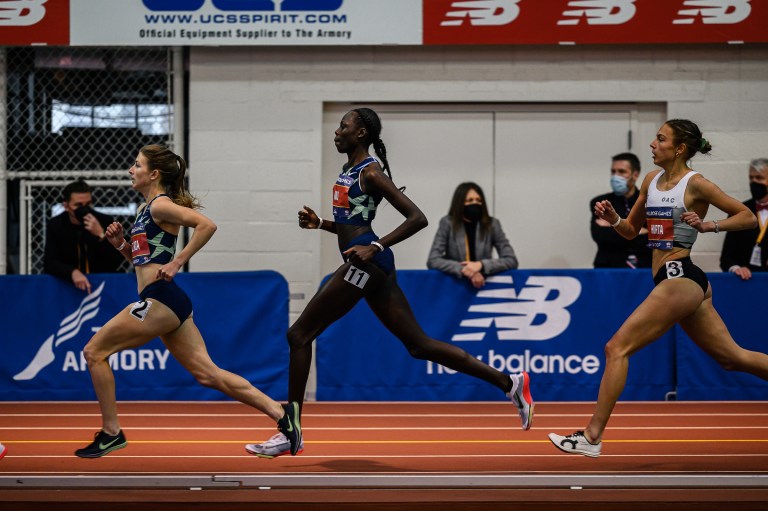
Defending champion Elle Purrier St. Pierre, though, wasn’t waiting around.
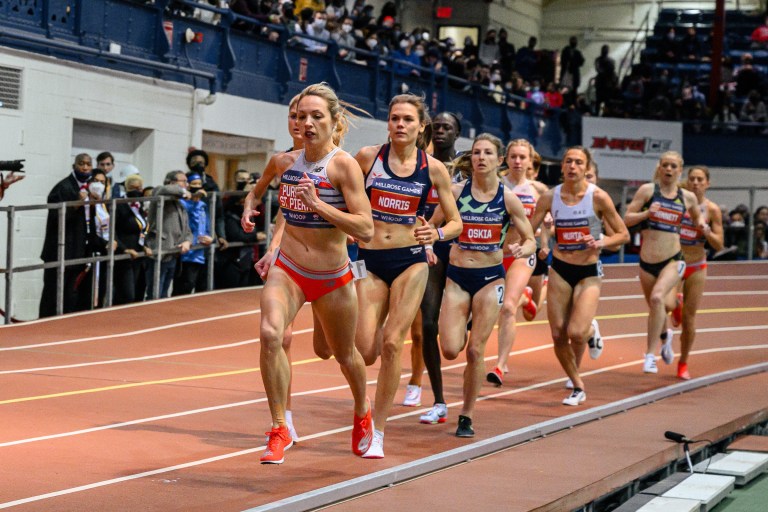
“If you don’t take the lead it’s going to be a tactical slow race. I don’t necessarily thrive in that scenario,” Purrier St. Pierre said. Mu wilted and stepped off the track with a lap to go, and Konstanze Klosterhalfen, who had dominated at Millrose in 2019 with her own aggressive racing, couldn’t mount a challenge.

Of the 36 women’s mile races at Millrose over the years, a time of 4:30 flat would have won more than half of them, but Purrier St. Pierre has ushered in a new era, running sub 4:20 in consecutive wins, this time breaking the tape in 4:19.
And what if somebody had been able to challenge her late? “I probably could have gone a little faster,” she said.
While Mu’s decision to run the mile provided an element of the unknown to the women’s race, Cole Hocker’s decision to opt for the 3000 left fellow Tokyo 1500m finalists, Ollie Hoare and bronze medalist Josh Kerr, the clear front-runners in the men’s Wanamaker mile. And, just like Purrier St. Pierre, they didn’t dawdle.
Hoare, who has been training with Dathan Ritzenhein’s On Athletics Club (OAC) hit the half in 1:54, stalked by Kerr and 2019 US indoor mile champ Craig Engels.

Kerr made his move with a lap and a half to go. “Ollie knew I was going to come at some point,” he said. “I was hurting, but my thought was hopefully that if I’m hurting, he was hurting.”
Hoare had expected Kerr to make a move, but not until the last lap. “I knew he was on me, and I knew he was relaxed,” he said. “When he passed me, I was able to rally. When he went early it actually worked to my advantage.” Hoare made his countermove on the backstretch of the last lap and held the lead from there, finishing in 3:50.83, the third fastest winning time in the meet’s history.
Finishing ninth in 3:59 was 38 year-old Nick Willis, who broke four minutes for the 20th consecutive year.
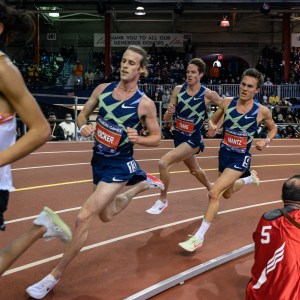
The most memorable kick at last year’s Olympic Trials was Cole Hocker’s to beat Matt Centrowitz in the 1500m. It was as if, watching television, somebody had pressed the fast forward button on him alone. In the latter stages of the 3000m at Millrose, the 20 year-old was positioned to unleash it again, this time on former Oregon teammate Cooper Teare.
In his many Wanamaker Mile wins, Bernard Lagat trained long-time Millrose fans to appreciate the beauty and lethality of a well-timed late race acceleration. And really, is there anything more exciting, or more primal, in track, then stalking the prey and finishing the chase?
In the most rousing lap of the day, Teare held off Hocker, who he knew would be coming, the two drifting into lanes two and three on the home straight. He stretched his arms. He thought he had it won. But wait! Bolting on the inside, like Tarzan out of the jungle, was Ollie Hoare’s On Athletics Club teammate Geordie Beamish, breaking the tape. His time of 7:39 set a New Zealand national record. He split the final 100 meter in 12.32.
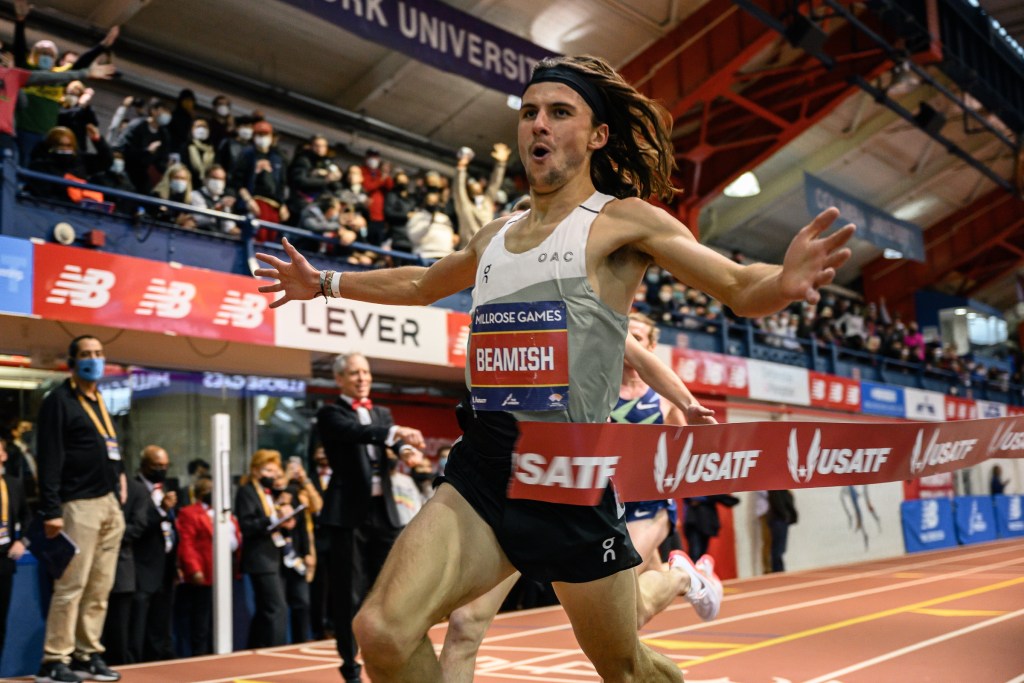
“I chose to do the 3k. I had the option of doing the mile, but I wanted a shot at Cole,” said Beamish. “That’s the part of running I like. I live for the last 150.”
The women’s 3000m race was yet another victory by an On Athletics runner, and if more methodical, the performance was no less impressive, as Alicia Monson sliced 10 seconds off the meet record with an 8:31. Monson was shadowed the entire race by Weini Kelati. With shorter strides and a higher turnover, Kelati seemed poised at any moment to make a move, but with two laps to go, Monson opened the gap. “I knew Weini would be right there. She did make me a little bit nervous clipping on my heels, but I feel like it helped me keep on the gas, and in the end leveled up both of our performances,” said Monson.
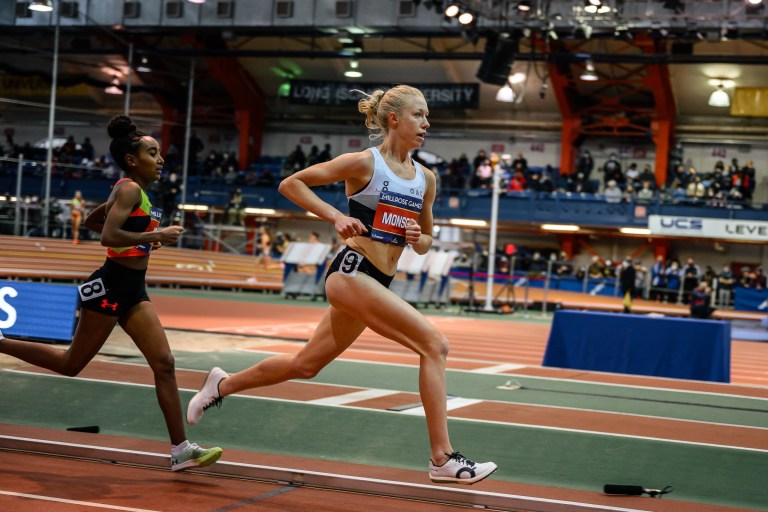
In the men’s 800, Bryce Hoppel weathered a big move by Michael Saruni on the third lap to get by him on the final straightaway of the fourth. “The main mindset is to stay out of trouble,” said Hoppel, his leg bloodied, after the race. “As long as he doesn’t get too far away, it’s still a race, that’s what goes through my mind.”
The most dominant performer at Millrose since it moved to the Armory in 2012, and one of its softest spoken, is Ajee Wilson. Athletes’ time on the top is often short-lived even in a non-contact sport like track, but Ajee won her 7th consecutive 800m at Millrose, including five wins head-to-head against Jamaica’s Natoye Goule, who was runner-up for the third consecutive time. Ajee carries herself with purpose and minimal drama, and wins by taking the lead but not pushing the pace. When the meet and all its racing had ended, she was one of a handful of pros running yet more laps around the track.
All photos by Johnny Zhang. See also our photo gallery and podcast on Millrose, including audio clips from the stars.
Categories: Ajee Wilson, Elle Purrier, Lagat, Millrose Games, Nick Willis, Wanamaker Mile
Leave a Reply